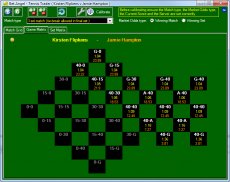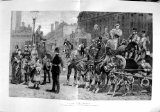15-40 Tennis strategy
 One of the beauties of Tennis trading is that there are many possible approaches which can all be successful, with some traders preferring to be exposed to risk, with others keener to take a more risk averse approach.
One of the beauties of Tennis trading is that there are many possible approaches which can all be successful, with some traders preferring to be exposed to risk, with others keener to take a more risk averse approach.
When laying a server, or the player a break up, we have previously discussed trading out if and when the break occurs. However for the purpose of this article, I want to look at taking money out during a service game.
To make matters slightly easier, I’ve grouped in-game scorelines into two brackets:-
- Small price movements: 1 Point Receiver Leads (no break point). This would be 0-15 and 15-30.
- Larger price movements: 2+ Point Receiver Leads, or 1 point break point leads. This would be 0-30, 0-40, 15-40, 30-40 or 40-A.
Typically, the price movement at 30-40 or 40-A will be bigger than at 0-15 or 15-30 due to the fact that it creates a break point opportunity for the receiver, whereas this is not the case at 0-15 or 15-30, which is why I have placed those scorelines in the second bracket.
I thought it would be pretty interesting to see how frequently these winning trade positions were hit during the average match (with no game selection) in various sets. However, before moving onto the actual stats, I will say that each set tends to have different dynamics.
My Game State spreadsheets illustrate this – for example, in the entire 2014 WTA season, the player a break down recovered the first break in the first set 52.8% of the time. However, in the second set, when a player was a set and break down, this deficit was recovered just 40.3% of the time. In the final set, this figure rose to the highest of all sets, 54.1%. It is not entirely surprising that the second set, from a set and break position, was the lowest percentage, as this position exhibits the most dominance from all three scenarios.
The following table shows the percentage small and larger price movements were achieved from a break down in the WTA, in January 2015:-
| Player Break Down | ||||||||
| Got to only | Got to at least | |||||||
| 0-15/15-30 | 0-30/15-40/30-40/40-A | |||||||
| Total Situations | Situations | Yes | No | 2 Pts/BP % | 1 Point at least % | Difference | ||
| Set 1 |
208 |
63 |
18 |
45 |
145 |
69.7 |
78.4 |
8.7 |
| Set 2 S&B |
150 |
62 |
23 |
39 |
88 |
58.7 |
74.0 |
15.3 |
| Set 3 |
74 |
26 |
48 |
64.9 |
75.7 |
10.8 |
||
| Overall |
432 |
151 |
49 |
102 |
281 |
65.0 |
76.4 |
11.3 |
The sample is quite revealing. A one point lead (smaller price movement) was achieved quite consistently throughout the sets, with set two, unsurprisingly, slightly lower than sets one or three.
You might also like



|
Wimbledon SW19 - WIMBLEDON THE HOME OF TENNIS - London Street Sign - Small Steel Sign Home (The Original Metal Sign Company.)
|

|
1889 Afternoon Scene Streets London Policeman Horses Home (old-print)
|

|
1889 London Streets Ludgate Horses Slipping Coach Home (old-print)
|

|
1874 LONDON STREET SCENE PAVEMENT ARTIST PEOPLE PRINT Home (old-print)
|

|
1900 Relief Mafeking London Street Scene Piccadilly Home (old-print)
|


